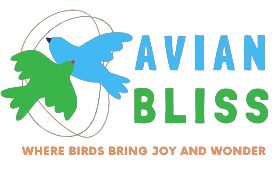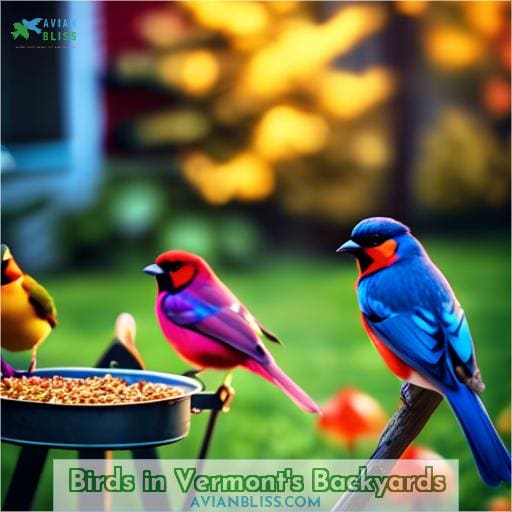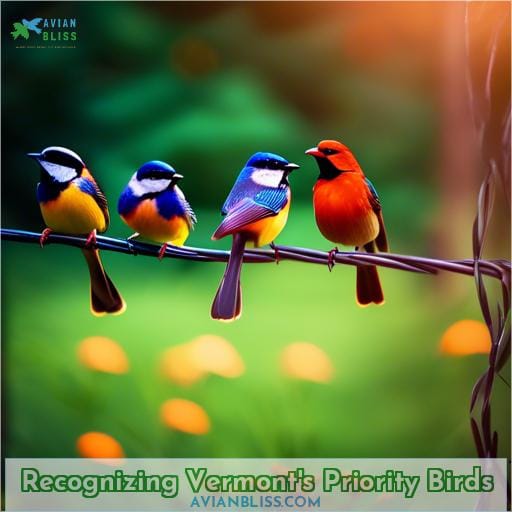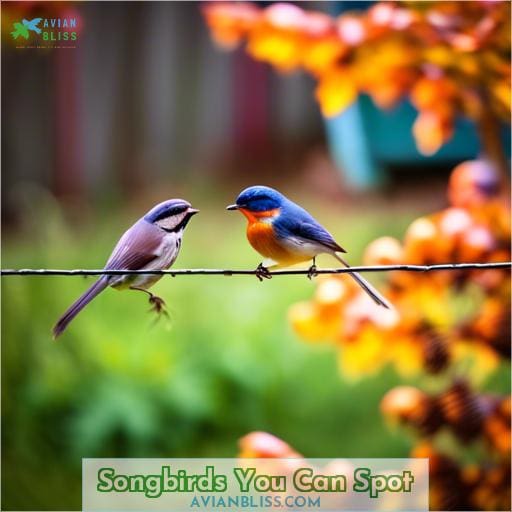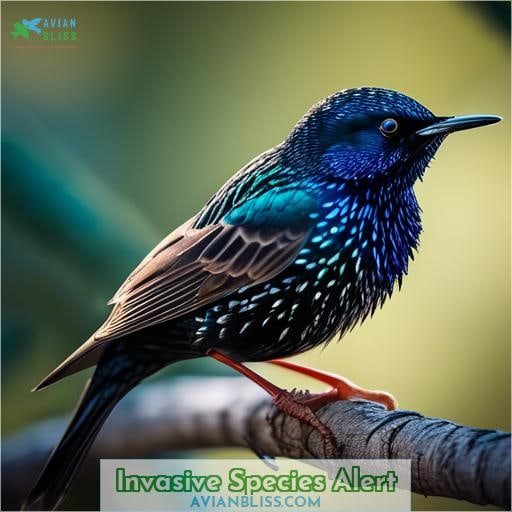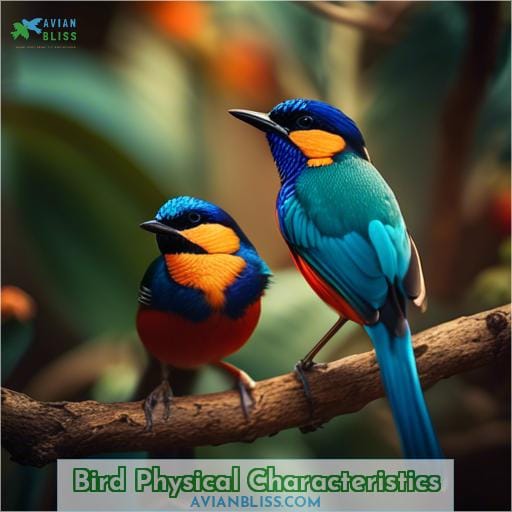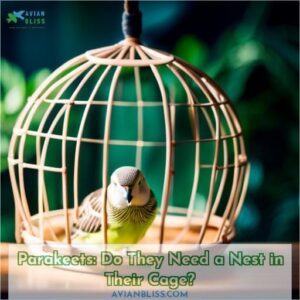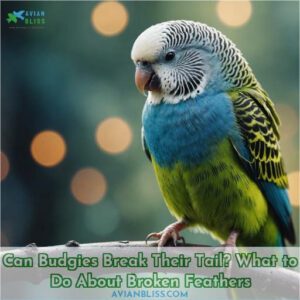This site is supported by our readers. We may earn a commission, at no cost to you, if you purchase through links.
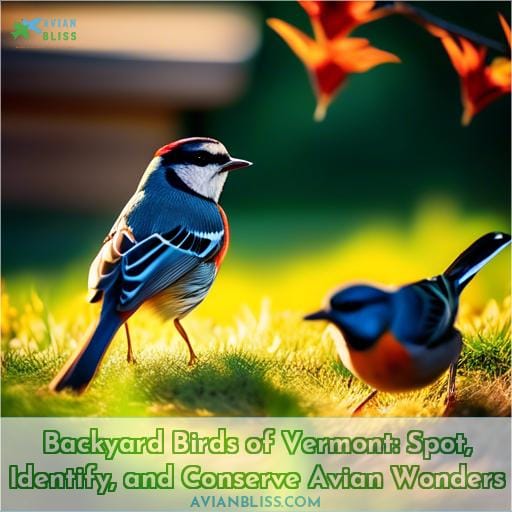 Imagine stepping into your backyard to the vibrant trills of the American Goldfinch, a moment that connects you to Vermont’s rich avian tapestry.
Imagine stepping into your backyard to the vibrant trills of the American Goldfinch, a moment that connects you to Vermont’s rich avian tapestry.
This guide to backyard birds of Vermont invites you to spot, identify, and conserve these avian wonders, fostering a deep sense of belonging and safety in nature’s embrace.
You’ll learn to recognize the songs and plumage of local species, contributing to their preservation while enriching your understanding of the natural world around you.
Table Of Contents
- Key Takeaways
- Birds in Vermont’s Backyards
- Recognizing Vermont’s Priority Birds
- The Joy and Benefits of Birdwatching
- Music and Hollywood Support Bird Conservation
- Vermont’s Diverse Bird Habitats
- Woodpeckers of Vermont
- Songbirds You Can Spot
- Invasive Species Alert
- Bird Physical Characteristics
- Bird Behaviors to Observe
- Frequently Asked Questions (FAQs)
- Conclusion
Key Takeaways
- Vermont’s birdlife offers a rich avian tapestry, including the vibrant trills of the American Goldfinch, fostering a deep connection to the natural world and a sense of belonging and safety in nature.
- Priority birds such as the Common Tern, Bobolink, and Peregrine Falcon highlight the importance of conservation efforts due to challenges like sparse nesting, climate change impacts, and the need to understand migration patterns and hunting techniques.
- Birdwatching in Vermont provides numerous benefits including reduced stress, increased happiness, a stronger connection with nature, and opportunities for community engagement in environmental conservation efforts, all contributing to mental well-being.
- Understanding bird habitats is crucial for conservation, with a focus on forest nesters, shrubland species, grassland avians, and specific birds like woodpeckers and songbirds, alongside the impact of invasive species like the House Sparrow on local ecosystems.
Birds in Vermont’s Backyards
As you step into your Vermont backyard, you’re not just entering an outdoor space; you’re stepping into a living aviary. Here, bird conservation efforts take flight, with each chirp and flutter underscoring the rich tapestry of bird species diversity.
Your garden could be a haven for the American Robin, its song a melodious backdrop to your morning. But beware, the invasive House Sparrow may also stake a claim, a reminder of the ongoing battle for habitat protection.
Arm yourself with backyard birdwatching tips, and even as a beginner, you’ll soon distinguish the House Wren’s trill from the crowd. Birding isn’t just a pastime; it’s a way to connect, protect, and play a part in the symphony of nature right outside your door.
Recognizing Vermont’s Priority Birds
You’ll find that Vermont’s priority birds, such as the Common Tern, Bobolink, and Peregrine Falcon, are key to understanding the state’s biodiversity. Each species offers unique insights into the health of their respective habitats and the broader environmental challenges they face.
Common Tern
As you delve into the world of Vermont’s avian wonders, the Common Tern emerges as a fascinating subject.
- Migration Marvels: These birds are globe-trotters, journeying vast distances between breeding and wintering grounds.
- Nesting Nooks: They prefer sparse, flat surfaces near water—think beaches or islands—for laying their eggs.
- Population Puzzle: Despite their wide range, their numbers prompt conservation efforts, intertwining their fate with Vermont’s environmental health.
Bobolink
Just like the Common Tern, the Bobolink is a gem among Vermont’s birds, thriving in well-managed grasslands. Their survival hinges on effective conservation partnerships, habitat restoration, and keen monitoring to mitigate climate change impacts.
Engaging in birding not only connects you with these migratory marvels but also plays a crucial role in safeguarding the future of Vermont’s bird species.
Peregrine Falcon
In Vermont’s chilly embrace, the peregrine falcon thrives, a testament to nature’s resilience.
These birds of prey showcase remarkable migration patterns, returning each year to familiar nesting sites atop cliffs and urban structures.
Their hunting techniques are a spectacle, diving at breathtaking speeds.
Despite past declines, conservation efforts have seen their numbers soar, marking a victory for both the falcons and Vermont’s wildlife enthusiasts.
The Joy and Benefits of Birdwatching
Birdwatching offers you a unique avenue to enhance your mental well-being, as the practice has been linked to reduced stress and increased happiness. By observing birds, you’re not only connecting with nature but also contributing to conservation efforts and fostering community engagement in environmental issues.
Birdwatching Mental Health
After spotting priority birds like the Peregrine Falcon, dive into birdwatching’s mental health oasis.
This hobby isn’t just about ticking off sightings; it’s a gateway to stress relief, deepening nature appreciation, and sparking environmental awareness.
Joining a community of bird enthusiasts can amplify your joy. Imagine the thrill of identifying an American Goldfinch or hearing a Northern Cardinal’s call—pure, unadulterated bliss.
Conservation Through Observation
As you peer into your backyard, consider how your observations aid conservation. Here’s how:
- Citizen Science: Your keen eye on the Downy Woodpecker or Eastern Bluebird contributes to vital data pools.
- Habitat Restoration: Spotting trends, like the Carolina Wren’s visits, informs restoration efforts.
- Community Outreach: Sharing snaps of the White-breasted Nuthatch fosters environmental education and unites bird lovers.
Community Environmental Engagement
Engaging with backyard birds in Vermont isn’t just a pastime; it’s a vital part of bird conservation efforts. Your observations fuel citizen science initiatives, contributing to community-based bird monitoring.
Environmental education programs thrive on such grassroots involvement, while habitat restoration projects often begin in our own backyards. So, grab your guide to bird identification by color, and join the community environmental engagement movement.
Music and Hollywood Support Bird Conservation
Transitioning from the serene joy and mental health benefits of birdwatching, we dive into an equally vibrant chapter where music and Hollywood’s glitterati lend their voices for a cause that’s close to our feathered friends.
Imagine the red-winged blackbird‘s call amplified by celebrity involvement, or the mourning dove’s coo underpinned by generous funding. This isn’t just about star power; it’s a harmonious effort to safeguard habitats, ensuring the American crow and the pileated woodpecker continue to grace our skies.
The Birdsong Project isn’t just a melody; it’s a movement where the blue jay’s vibrant blues and the beats of conservation merge, showcasing how every tweet and trill contributes to a larger symphony of environmental stewardship.
Vermont’s Diverse Bird Habitats
Vermont’s landscapes offer a mosaic of habitats that are crucial for the survival of various bird species. From the dense forests that shelter nesters to the open shrublands and grasslands, each environment plays a pivotal role in the avian ecosystem.
Forest Nesters
Transitioning from the glitz of Hollywood’s support for bird conservation, let’s delve into the serene world of Vermont’s forest nesters. Here, the dance of habitat restoration plays a crucial role in the lives of our feathered friends.
- Forest Conservation ensures the survival of species like the secretive brown-headed cowbird.
- Habitat Restoration offers a haven for the melodious white-throated sparrow.
- Nesting Ecology reveals the intricate lives of red and black birds, from the vibrant hairy woodpecker to the elusive.
- Migration Patterns connect us globally, reminding us that every bird’s journey is a story woven into the fabric of our shared environment.
Let’s keep our ears tuned and our binoculars ready for these avian wonders!
Shrubland Species
Transitioning from the leafy abodes of forest nesters, let’s delve into the thicket of Vermont’s shrubland species.
Here, conservation concerns are paramount as bird-friendly landscaping nurtures the likes of the rose-breasted grosbeak and the secretive gray catbird.
While birding in shrublands, you might glimpse the chipping sparrow or the regal white-crowned sparrow, and don’t forget to look for flashes of yellow birds darting through.
Grassland Avians
Shifting from the dense shrublands, let’s dive into the open arms of Vermont’s grasslands.
Here, conservation initiatives are the unsung heroes, safeguarding the stage for a spectacular show of migration.
The Baltimore Oriole and House Finch, alongside the Pine Siskin and even the humble Rock Pigeon, play their parts.
But remember, the Vermont State Bird remains the star of this avian ballet.
Woodpeckers of Vermont
Turning your attention to Vermont’s woodpeckers, you’ll find the Downy Woodpecker’s identification fascinating due to its unique markings and behaviors. In exploring the Hairy Woodpecker’s habitat, you’ll uncover how these birds adapt to and thrive in their specific environments.
Downy Woodpecker Identification
Transitioning from the lush habitats that cradle Vermont’s avian life, let’s zero in on the downy woodpecker.
This tiny dynamo, with a penchant for suet and sunflower seeds, mirrors the resilience of the ruby-throated hummingbird braving winter’s snow.
Its nesting antics and diet shifts underscore its survival savvy, a beacon for conservation efforts.
Spotting one is like finding a feathered treasure.
Hairy Woodpecker’s Habitat
In Vermont, the Hairy Woodpecker’s habitat is a testament to nature’s ingenuity. These birds have adapted unique foraging strategies, especially during the breeding season.
- They prefer mature forests for nesting locations.
- Conservation efforts focus on habitat restoration.
- They’re adept at finding food in bark crevices.
- Their presence indicates a healthy ecosystem.
Songbirds You Can Spot
You’ll marvel at the American Robin’s clear whistle, a familiar sound in Vermont’s backyards. The American Goldfinch’s musical trills and warbles, meanwhile, add a vibrant soundtrack to your outdoor observations.
American Robin’s Whistle
As you wander through Vermont’s backyards, the American Robin’s song—a clear, melodious whistle—becomes your guide to their world.
Near the Robin’s nest, tucked in the crook of a tree, this bird thrives on a diet of worms and berries.
Their migration patterns bring them back each spring, filling habitats from forests to gardens.
Listen closely; their song weaves the fabric of early mornings.
American Goldfinch’s Trills
As you tune into the American Goldfinch’s trills, you’re not just hearing chirps; you’re witnessing a symphony of survival.
- Conservation: Their melodies signal the health of our ecosystems.
- Migration: Each note maps their journey, hinting at changes in habitat and food sources.
- Population Trends: Listening closely, we decode clues about their numbers, guiding our efforts to protect these vibrant voyagers.
Invasive Species Alert
As you delve into the world of backyard birding in Vermont, it’s crucial to keep an eye out for the House Sparrow, a bird that’s stirred up quite the competition for our native feathered friends.
These little invaders are notorious for muscling in on nest cavities meant for native species, making them a bit of a bully in the bird world. But don’t let their small size fool you; House Sparrows are a force to be reckoned with.
As an invasive species, they’ve carved out a niche for themselves, often at the expense of our local avians. So, while you’re out there enjoying the chirps and tweets, remember to support our native birds in this aerial tug-of-war for home and hearth.
Bird Physical Characteristics
You’ll find that identifying marks and bill shape variations are key to distinguishing Vermont’s backyard birds. These characteristics offer a window into each species’ unique adaptations and ecological roles.
Identifying Marks
In the world of Vermont’s backyard birds, distinctive markings and unique patterns are your roadmap to identification. From the coloration variations that paint a picture of species diversity to the bill adaptations that hint at dietary habits, every detail matters.
Bill Shape Variations
Just as a detective deciphers clues, you’ll find bill length and shape are vital for bird ID. Take the woodpecker’s chisel-like bill, perfect for tree-boring. Or the finch’s stout beak, ideal for seed-cracking.
Observe the curvature, thickness, and color—each a piece of the puzzle. It’s like nature’s Swiss Army knife, each species with a beak fine-tuned for survival.
Bird Behaviors to Observe
As you observe Vermont’s backyard birds, take note of their feeding habits; certain species show strong preferences for specific seeds and suet. Additionally, many birds, like the American Robin, often choose nesting sites in close proximity to human activity, offering unique opportunities for observation.
Feeding Preferences
When you’re setting up bird feeders, it’s like rolling out a welcome mat for feathered friends.
- Seed preference: Finches fancy Nyjer, while sunflower seeds are the all-you-can-eat buffet for a bevy of birds.
- Diet variations: Woodpeckers are suckers for suet; it’s like their version of a guilty pleasure.
- Seasonal changes: As seasons shift, so do birds’ menus, impacting conservation efforts. Keep an eye out!
Nesting Near Humans
After discussing feeding preferences, let’s dive into nesting near humans.
Birds, like the American Robin, often choose our backyards for their homes, drawn by bird-friendly landscaping and year-round feeding opportunities.
Proper birdhouse placement and nest box monitoring are key to habitat preservation.
This connection not only fosters a sense of belonging and safety but also turns our gardens into avian sanctuaries.
Frequently Asked Questions (FAQs)
How do migratory patterns affect Vermont birds?
Migratory patterns toss Vermont’s birds into a seasonal dance, navigating climate’s whims. They’re like feathered tourists, seeking summer homes or winter retreats, ensuring survival but facing the music of changing habitats and weather extremes.
What bird species are climate-sensitive in Vermont?
Vermont’s feathered denizens, like the Wood Thrush and Bicknell’s Thrush, are on thin ice as climate change threatens to remodel their woodland homes and migratory waypoints.
How to create bird-friendly backyard environments?
To invite feathered friends over, mix native plants with bird feeders and water sources.
What are Vermont’s rarest backyard bird sightings?
Vermont’s rarest backyard bird sightings, like the elusive marbled godwit, stir excitement and curiosity. You’re not just spotting birds; you’re uncovering nature’s hidden gems, creating a sense of belonging and safety in your own backyard adventure.
How do urban areas impact Vermont birdlife?
Bustling urban areas blanket birds in a bubble of blight, as light and noise pollution disrupt delicate diurnal rhythms, diminishing diversity and driving away the dulcet tones of Vermont’s varied avian voices.
Conclusion
As the sun sets on our exploration of Vermont’s backyard birds, you’re now equipped to engage with these winged marvels.
Your newfound knowledge empowers you to identify, appreciate, and protect the avian wonders that grace your surroundings.
By observing their behaviors and habitats, you contribute to conservation efforts, ensuring these birds continue to thrive.
Embrace this journey; let the backyard birds of Vermont guide you to a deeper connection with the natural tapestry of life.
